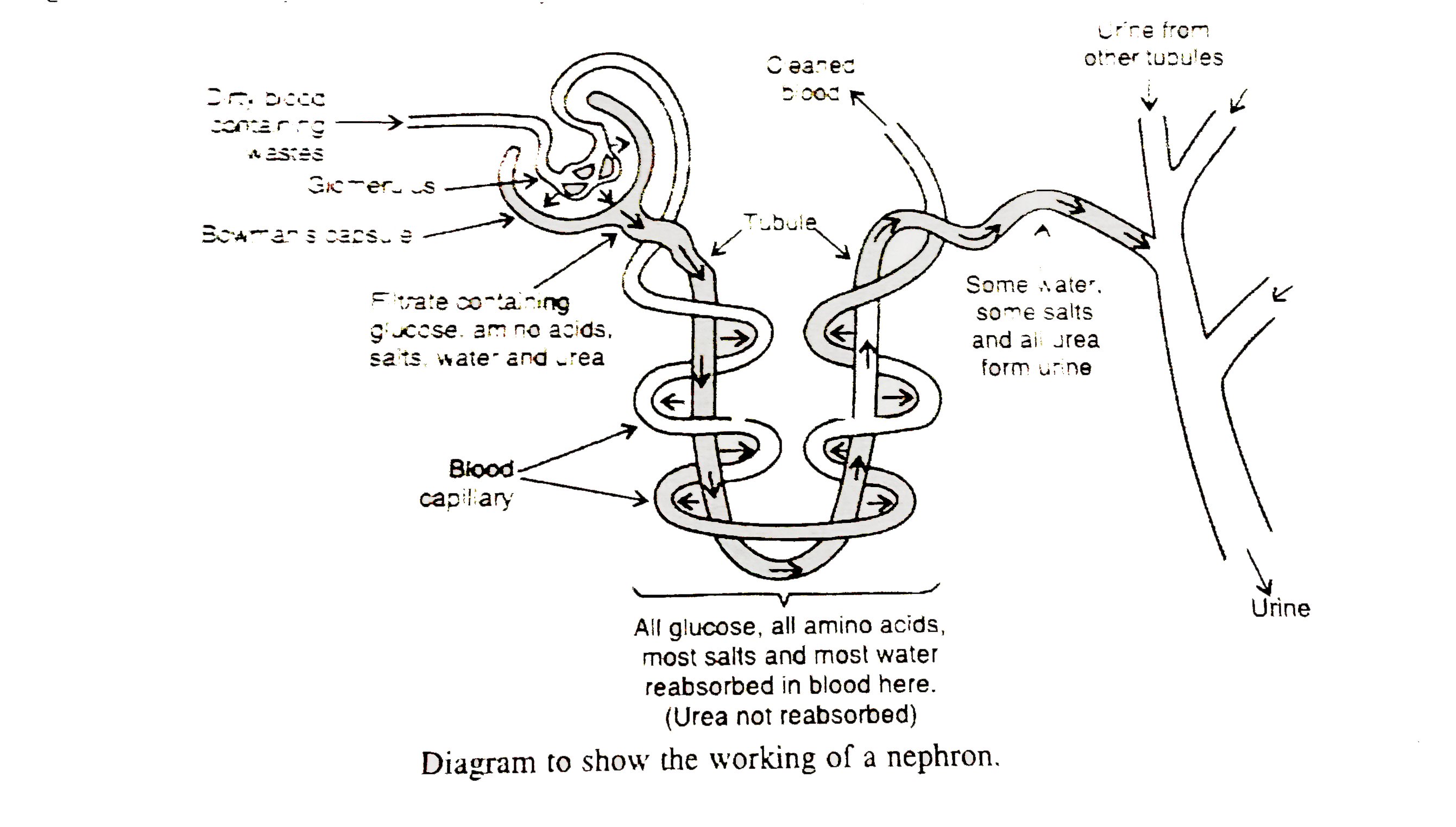Describe the structure and functioning of nephrons.
The nephron has a cup-shaped bag at its upper end which is called Bowman's capsule. The lower end of Bowman's capsule is tube-shaped and it is called a tubule. The Bowman's capsule and the tubule taken together make a nephron (Each kidney has about 1 million nephrons). One end of the tubule is connected to

Bowman's capsule and its other end is connected to a urine-collecting duct of the kidney. The Bowman's capsule contains a bundle of capillaries which is called glomerulus. One end of glomerulus is attached to renal artery which brings the dirty blood containing the urea waste in it. The other end of glomerulus comes out of Bowman's capsule as a blood capillary, surrounds the tubule of nephron and finally joins a renal vein (putting urea-free clean blood into it). The function of glomerulus is to filter the blood passing through it.
The dirty blood containing waste like urea (brought by renal artery) enters the glomerulus. The glomerulus filters this blood. During filtration, the substances like glucose, amino acids, salts, water and urea, etc., present in the blood pass into Bowman's capsule and then enter the tubule of nephron. When the filtrate containing useful substances as well as the waste substances through the tubule, then the useful substances like all glucose, all amino acids, most salt, and most water, etc., are reabsorbed into the blood through blood capillaries surrounding the tubule. Only the waste substances urea, some unwanted salts and excess water remain behind in the tubule. The liquid left behind in the tubule of nephron is urine. The nephron carries this urine into the collecting duct of the kidney from where it is carried to ureter. From the ureter, urine passes into urinary bladder. Urine is stored in the bladder for some time ultimately passed out of the body through urethra.
Topper's Solved these Questions
- BOOK - LAKHMIR SINGH & MANJIT KAURCHAPTER - LIFE PROCESSESEXERCISE - very short answer type question1videos
LIFE PROCESSES
- BOOK - LAKHMIR SINGH & MANJIT KAURCHAPTER - LIFE PROCESSESEXERCISE - short answer type question3videos
LIFE PROCESSES
- BOOK - LAKHMIR SINGH & MANJIT KAURCHAPTER - LIFE PROCESSESEXERCISE - question based on high order thinking skills1videos
LIFE PROCESSES
- BOOK - LAKHMIR SINGH & MANJIT KAURCHAPTER - HOW DO ORGANISMS REPRODUCE EXERCISE - QUESTIONS BASED ON HIGH ORDER THINKING SKILLS (HOTS)27videos
HOW DO ORGANISMS REPRODUCE
- BOOK - LAKHMIR SINGH & MANJIT KAURCHAPTER - MANAGEMENT OF NATURAL RESOURCES EXERCISE - VALUE BASED QUESTIONS25videos
MANAGEMENT OF NATURAL RESOURCES
Similar Questions
Describe the structure and function of a nephron.
View SolutionDescribe the structure and function of ATP.
View SolutionDescribe the structure and function of pancreas.
View SolutionDescribe the structure and functions of nucleus.
View SolutionDescribe the structure and functions of nucleus.
View Solution(a) Write the functions of the following parts in human female reproductive system:
(i) Ovary (ii) Oviduct (iii) Uterus
(b) Describe the structure and function of placenta.View Solution(a) Write the functions of the following parts in human female reproductive system:
(i) Ovary (ii) Oviduct (iii) Uterus
(b) Describe the structure and function of placenta.View SolutionDescribe the structure and functions of epithelium.
View SolutionDescribe the structure and function of thyroid gland.
View SolutionDescribe the structure and functions of areolar connective tissue.
View Solution

